Emmanuelle Gall and her genealogy: a lifetime's work
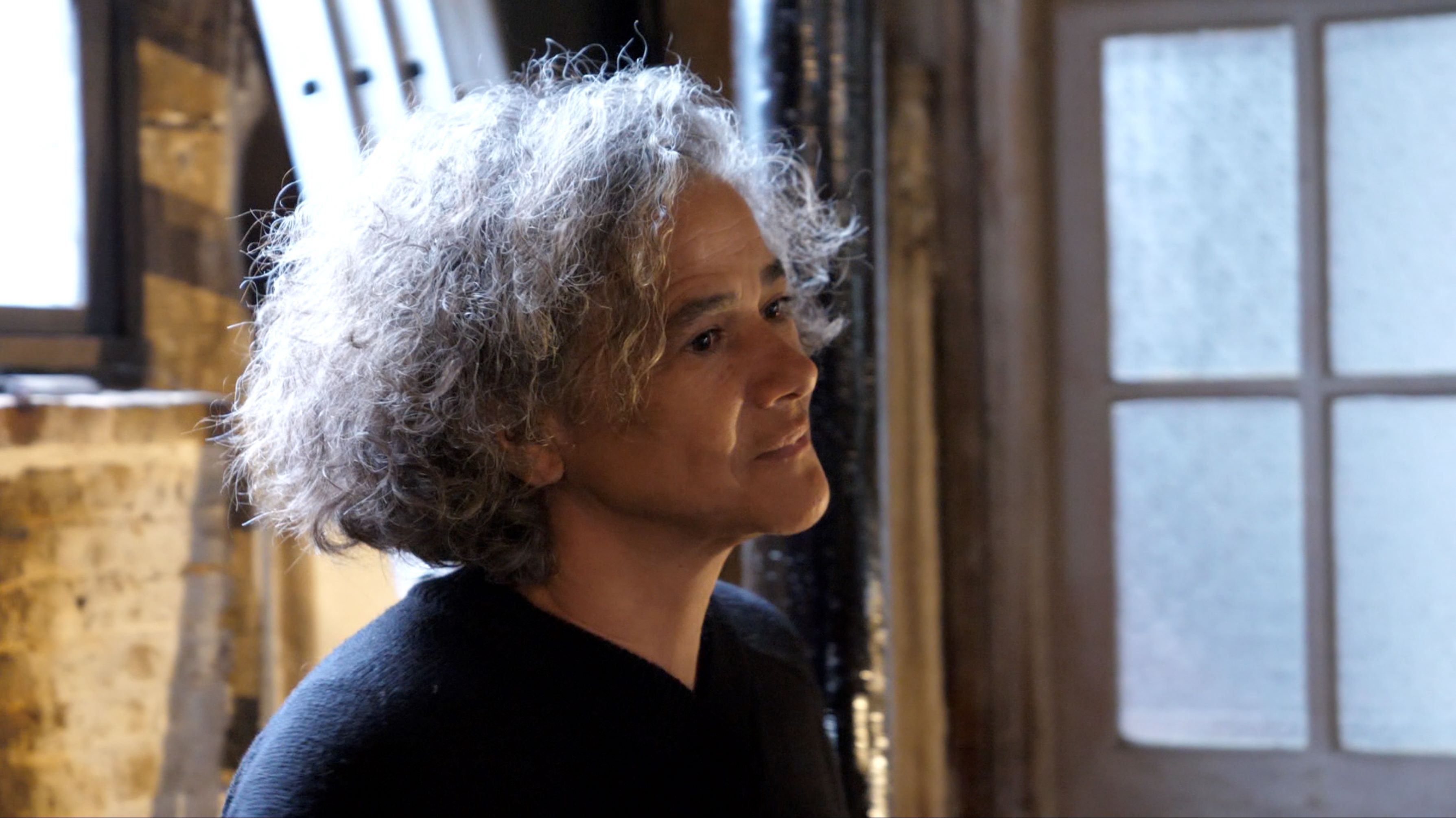
Emmanuelle Gall's Portrait (c) Xavier Degremont
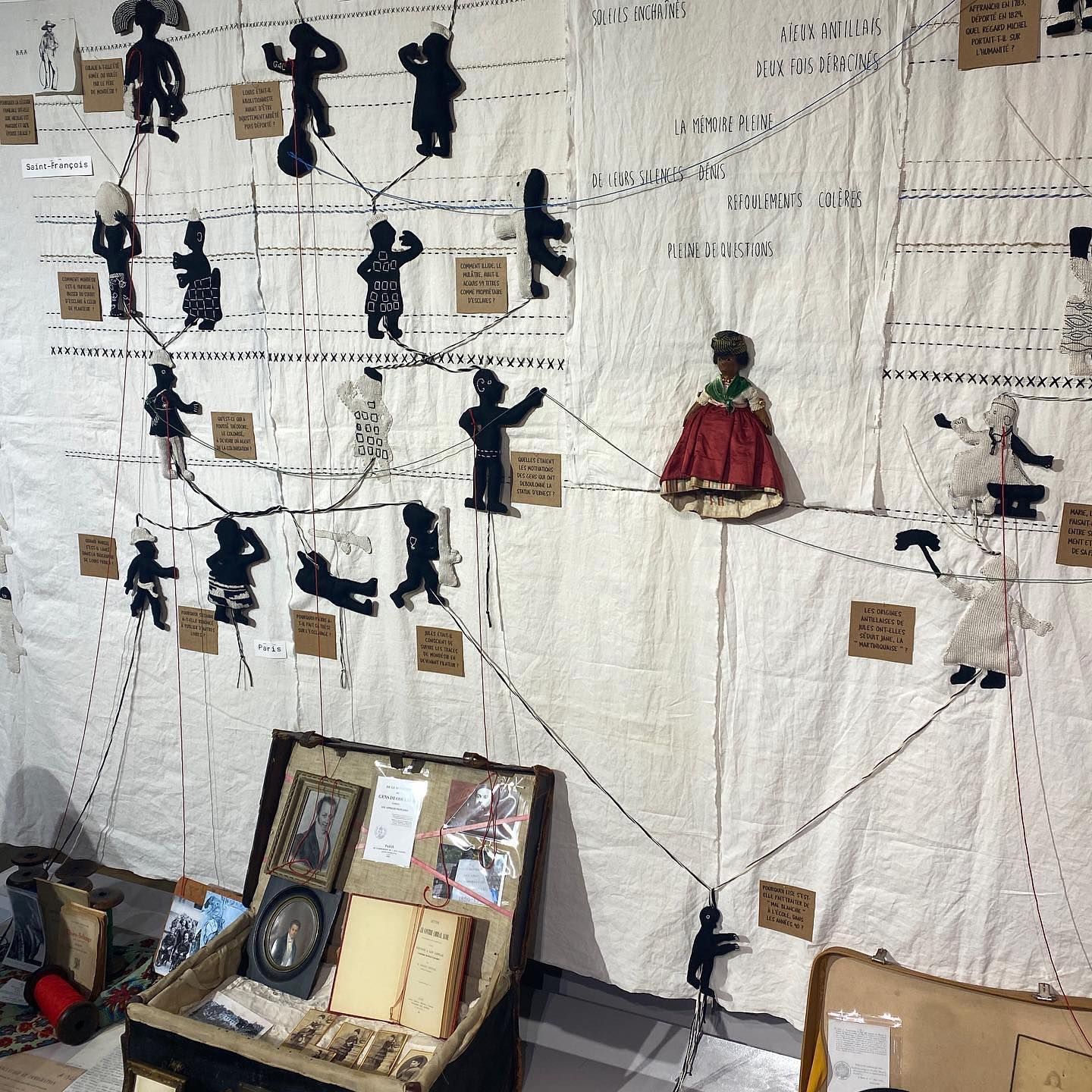
Emmanuelle Gall's genealogy installation at Musée de la Corderie Vallois May 2023 (c) RMM
As an author and visual artist Emmanuelle Gall's approach follows the traces of a family history crossing Rouen and the West Indies. Thus, she gives shape to a memory that is both intimate and collective, rooted in the tragedy of slavery and the silences that covered it up. Emmanuelle Gall is the great-grand-niece of Suzanne Lacascade, author in 1924 of a seminal novel, born at the dawn of the literary and artistic effervescence of negritude: “She left no other legacy than her novel and a West Indian doll: a leather “popote” made during the Second Empire that my grandmother passed on to me on her behalf [...]. Little did I imagine at the time that I would discover Claire-Solange, African soul, a dozen years later at the Sorbonne, during a lesson by Régis Antoine devoted to the first texts of West Indian literature.” Since then, she has never abandoned her creative quest, lifting the veils of oblivion back to her mysterious ancestor Eulalie, Suzanne's great-grandmother, enslaved then freed in 1835. Emmanuelle Gall explores a genealogy woven of stories and powerful feminine imaginations that transcend generations. She invokes the right to memory and summons her ancestors in the form of an installation-inquiry, made up of images and narratives that weave together history.
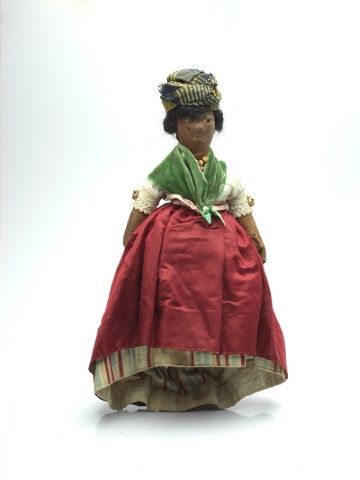
“I'm eight or nine. Maybe ten. My grandmother hands me a boiled cardboard box. Inside, wrapped in tissue paper, lies a brown leather doll. - It's a gift from the old aunts. Be careful, it's very fragile, so don't play with it! One day, you'll give it to a museum! I've become the doll's keeper. And I think the reverse is also true.”
Antillean doll or “popote”,
Martinique,
2nd half of the 19th century
Suzanne Lacascade collection, then Emmanuelle Gall collection
Contemporary creations
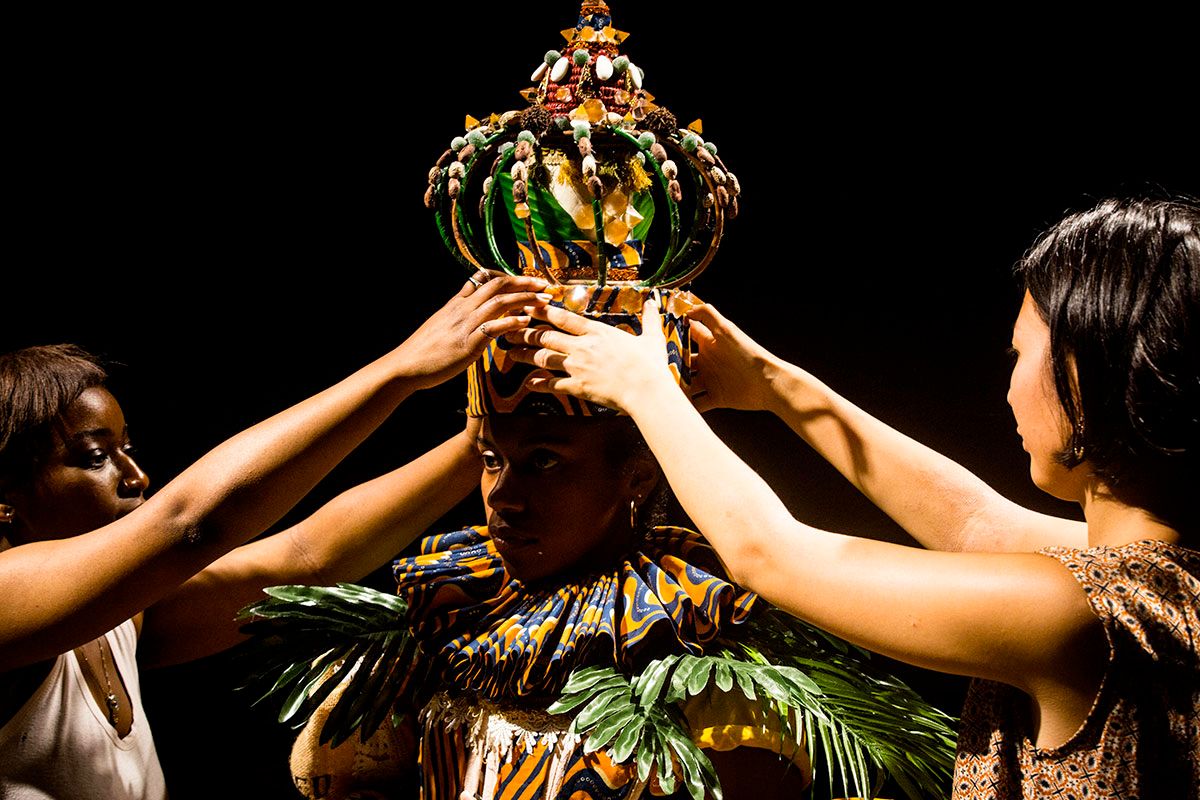
What did people eat for breakfast in France in 1777? How long have we been cooking tomatoes? Where do bananas, rice, cocoa and potatoes come from? All these foods that make up our daily lives are the fruit of a long journey that began with Christopher Columbus and continues today all the way to China, in the tomato fields belonging to the China National Cereals, Oils and Foodstuff Corporation. With her show Autophagies, designed to be performed in any space as long as you can cook in it, Eva Doumbia and a multi-disciplinary team invite the audience to a documentary eucharist. As peanuts, oils, bananas, chocolate, tomatoes and other vegetables are being cooked, performers, artists and researchers share intimate and banal anecdotes, all in music, poetry, dance and video.
Autophagies
Premiered July 14, 2021 at the Festival d'Avignon
Produced by La Part du Pauvre/ Nana Triban
Directed by Eva Doumbia
(c) Cie La Part du Pauvre
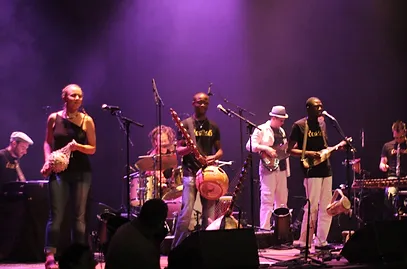
Originally, DonKaDi was a gathering of dancers and musicians from Mali. Today, it's about sharing African culture for moments of joy. The company is produced by Testa Duende, an association founded in 1999 to promote live performance and intercultural exchange through creative work. DonKaDi offers several shows, including a participatory ball, An evening in the maquis. In West Africa, the maquis is a place where people go out at night to have a drink, meet new people, listen to good music and dance.
An evening in the maquis
Produced by Testa Duende, Cie DonKaDi
Directed by Hannah Woods
Created in 2013
With Hannah Wood, Julien Barré, Max Couty, Nicolas Jozef Fabre, Bagaoussou Koné, Tom Saint Martin, Estelle AffagardEmilie Barteau, Séné Coulibaly, Mouna Coulibaly, Karine Hellot, Lucie Lepicard, Delphine Martial, Zoé Morainville, Anne-Laure Renais, Caro Renel, Amélie Touzé
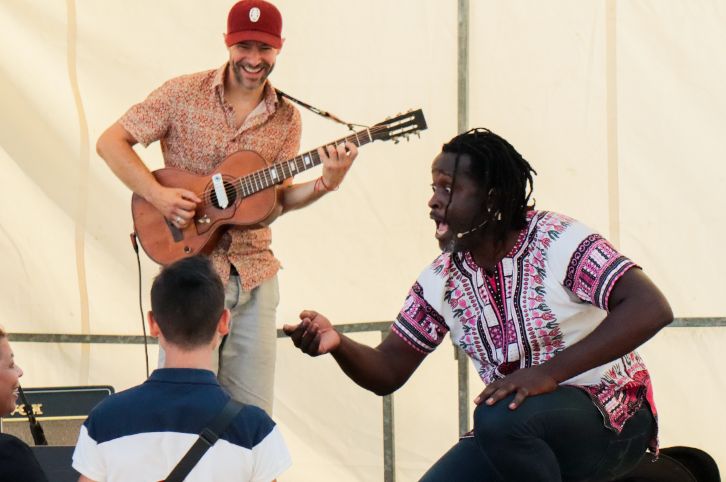
“They say it all started because Africans don't have souls. What is a soul? As a Congolese, I set out to find out. I've walked the roads of Loango, trod the soil of Aimé Césaire, talked with the Nèg Marrons. And today, I'm taking to the road to share it with you.” As a playwright and the Youle Compagnie co-founder, Ulrich N'toyo is actively involved in the creation of live shows. For the past four years, Ulrich N'toyo has been working on the subject, traveling on several occasions to the West Indies and Congo-Brazzaville to collect the memories of Afro-descendants and translate them into text, highlighting an essential question: what heritage are we leaving young people to understand this history? The show The Bumblebee is the result of these reflections and encounters, opening up discussion on this subject and leaving the world the choice of seizing it.
Ulrich N'toyo at his show Statements of the road - collecting stories
Musée de la Corderie Vallois Réunion des Musées Métropolitains
(c) RMM
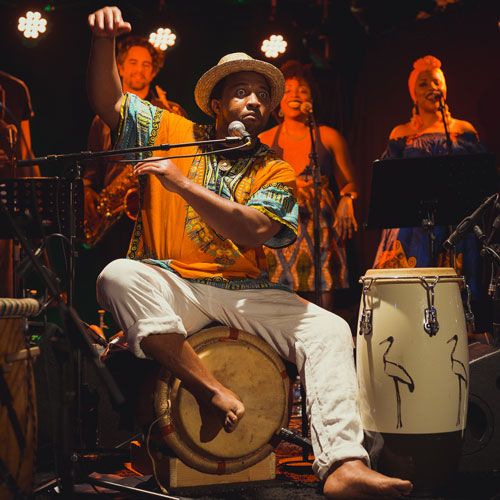
Philippe Gouyer-Montout - also known as Philo - hails from Martinique. Through contact with his great-cousins and village elders, including his grandfather Jovany Plumber and his uncle, he was first introduced to drumming: bèlè, danmié, chouval bwa and Guadeloupean gwoka were to stay with him throughout his childhood. In 2002 and 2005, Philo self-produced two EPs entitled Philo and The Drums Voices Vol. 1 and 2, which were part of a project that won awards from the Région Normandie in 2004 and 2005. His collaboration with Guadeloupean artist Frantz Féréol enable the two artists to transmit through their creations the very essence of their traditions and reinvent these rhythms forged by deportees during the transatlantic slave trade.
Philippe Gouyer-Montout © Julien Remy
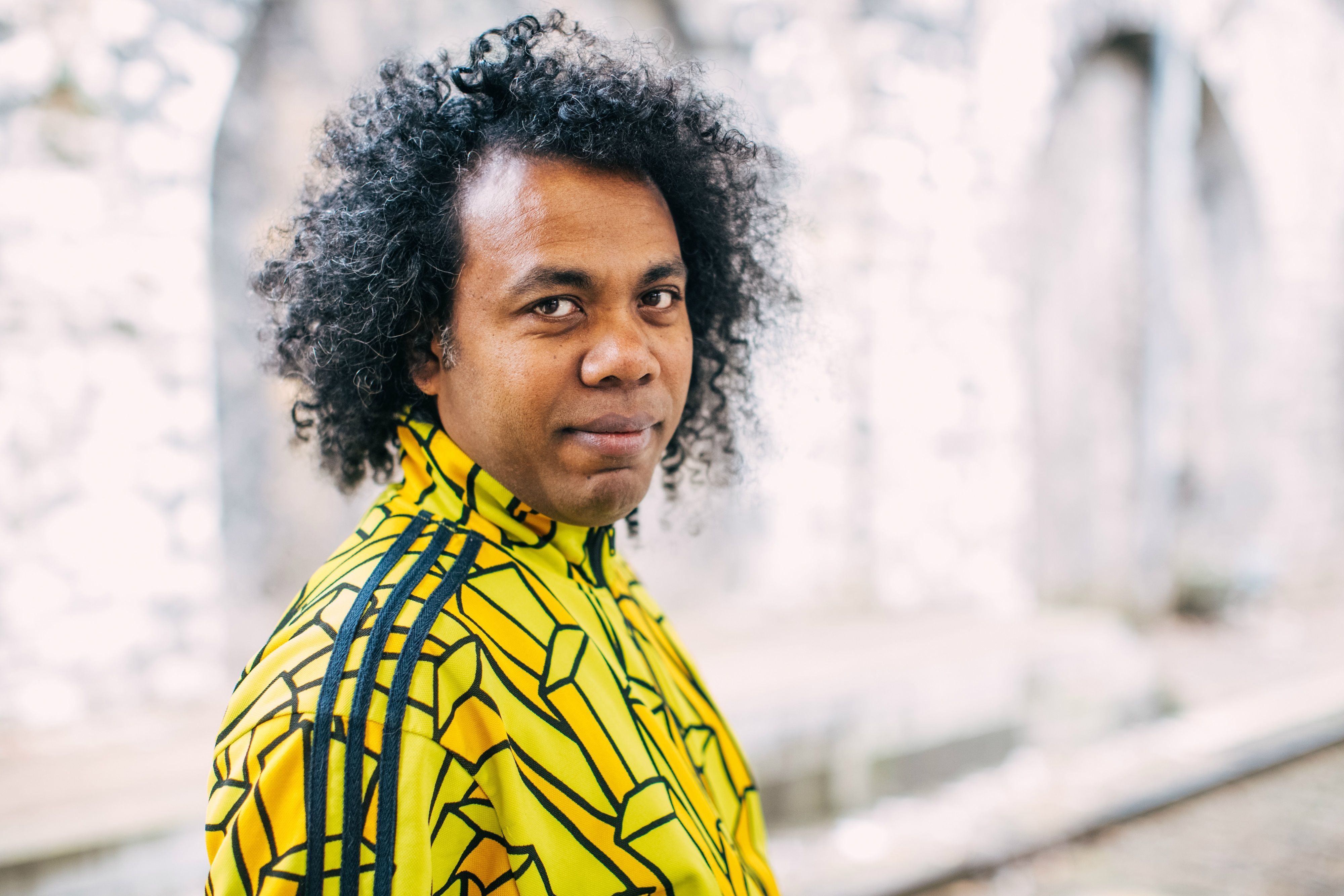
“I'm from Normandy, but not only am I a Norman. I was born in the Indian Ocean and, every year, I try to go to a different country to discover the music”. Sébastien Lejeune, whose artist name is Loya, is a multi-instrumentalist from La Reunion who uses his electronic machines to explore the traditional music of the Indian Ocean, bringing its richness to Normandy. With a background in jazz and African music, Loya explores his roots from La Reunion and mixes them with synthetic music to create a surprising and explosive electronic maloya, blending the codes of an ancestral traditional music - listed as a UNESCO intangible heritage site in 2009 - with the much more recent codes of electronic music.
Loya © Jacob Khrist
Contemporary productions about memories of slavery in Le Havre
vf.jpg)
Lambeaux #S-A , Gilles Elie-Dit-Cosaque
©Gilles Elie Dit Cosaque
Lambeaux and Xslave are two contemporary contributions by Gilles-Elie-Dit-Cosaque, movie director, graphic designer, photographer and visual artist. "It's a work, a reflection on memory, how it is formed, deformed. What remains of it, and how does it shape and deform us? How do parts of memory, including its tragic, painful and dark aspects, make a community? It's a way of questioning the here and now and confronting iconography with history, suggesting intimate stories".
Notice (c) Musée d'Arts et d'Histoire du Havre
vf.jpg)
Elisa Moris Vai Ruddy au studio 2020, Tirage jet d’encre sur Hahnemühle Photo Rag, contrecollé dibond, 20,8 x 25,7 cm © Elisa Moris Vai
vf.jpg)
Elisa Moris Vai Ruddy 2020 still, vidéo, 1min13. Lieu : Ministère des Outre-mer, Paris © Elisa Moris Vai
Work composed of photographic portraits of men and women who recognize themselves as descendants of slaves, posing in the manner of 17th-century paintings. A filmed portrait accompanies each photograph. Elisa Moris Vai's work evokes the legacy of slavery in French society. Questioning collective representations is at the heart of her approach.
Contemporary productions about memories of slavery in Honfleur
.jpg)
Pascale Monnin, Homo numericus oppressé, la dette de l'indépendance
© Pascale Monnin
Throughout the time of the exhibition, La Lieutenance, a center for the interpretation of architecture and heritage, organized guided tours to “make the walls” of the town speak, questioning the traces of the Atlantic slave trade in contemporary urban space. From Saturday July 8 to Sunday August 13, the Greniers à Sel had exhibited works by visual artist Pascale Monnin. Her work is intimately linked to the history of the free black republic of Haiti. Her work celebrates dreams, nomadism and freedom, and contributes to the inevitable questioning of our societies impacted by frenzied globalization.
Notice (c) Musée de Honfleur